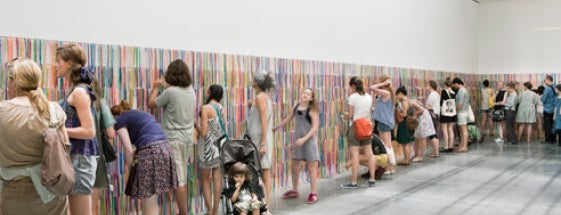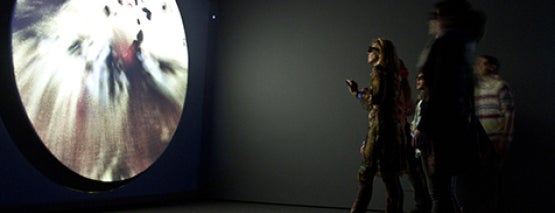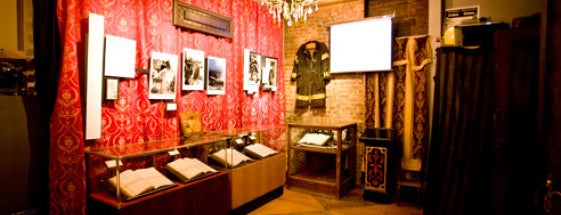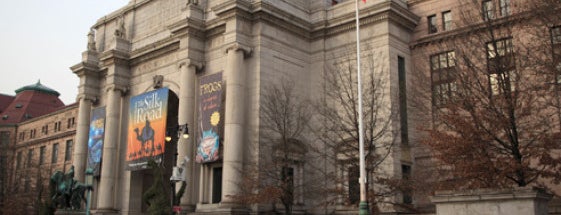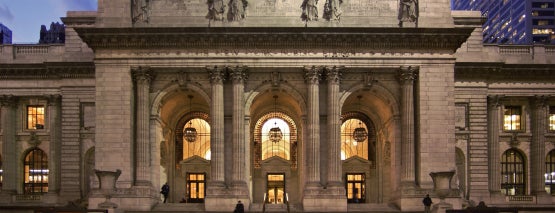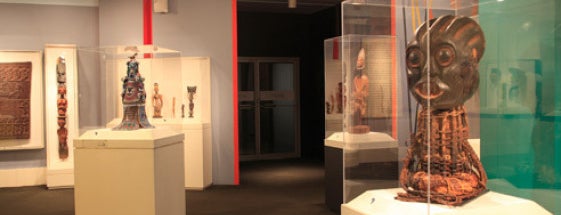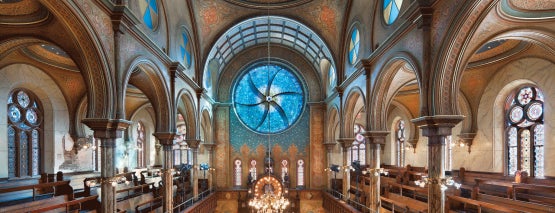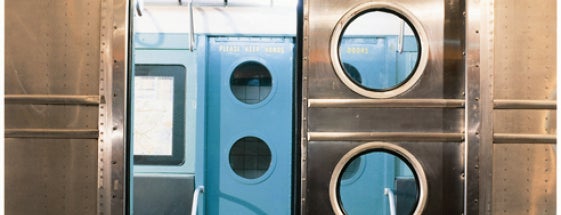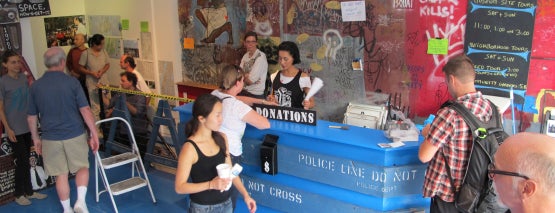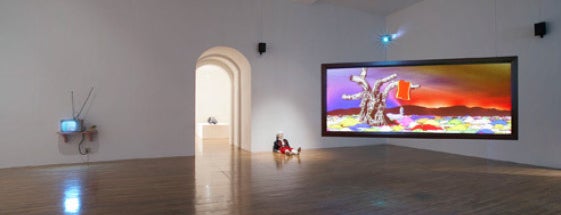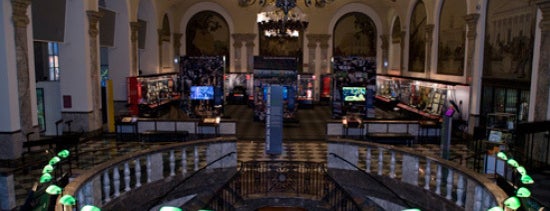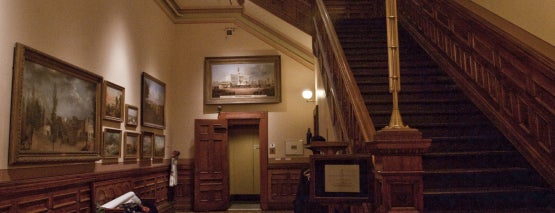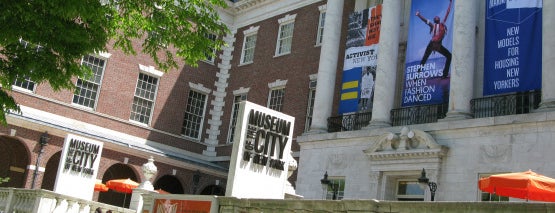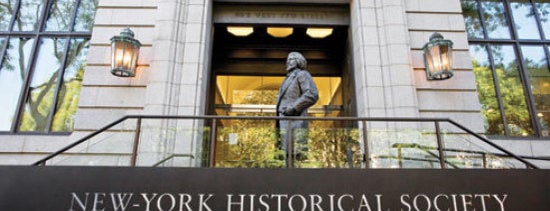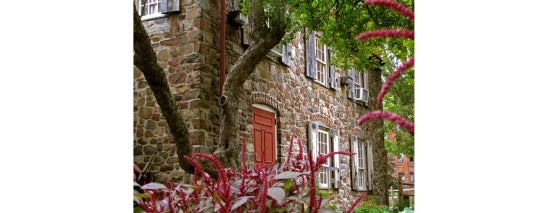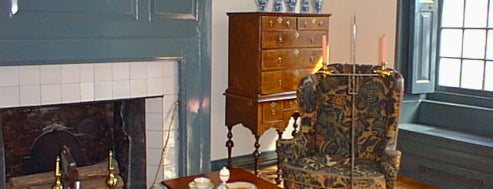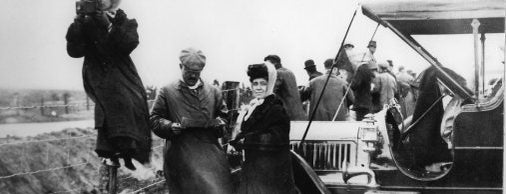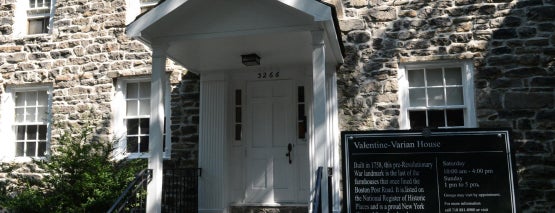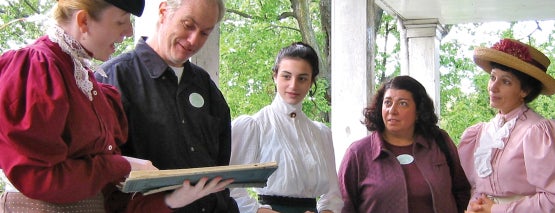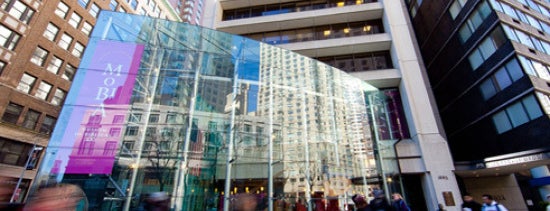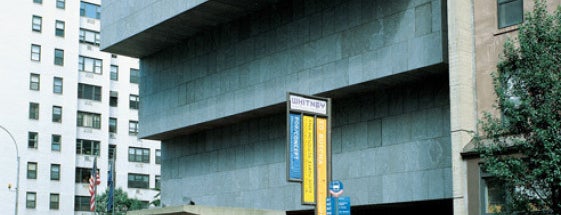![]() Since 1985, Conceptual artist Adrian Piper has been collecting her hair and toenails in empty honey jars. Whenever she fills one, she adds it to a shelf on display at What Will Become of Me at MOMA.
Read more.
Since 1985, Conceptual artist Adrian Piper has been collecting her hair and toenails in empty honey jars. Whenever she fills one, she adds it to a shelf on display at What Will Become of Me at MOMA.
Read more.
![]() The C-3PO tape dispenser in the Behind the Screen exhibit was produced to promote The Empire Strikes Back; the company responsible also made mugs featuring the heads of other Star Wars characters. Read more.
The C-3PO tape dispenser in the Behind the Screen exhibit was produced to promote The Empire Strikes Back; the company responsible also made mugs featuring the heads of other Star Wars characters. Read more.
![]() A remnant from a long-forgotten Gotham, the wooden brick is from the last-known wooden sidewalk in Brooklyn, which ran along Greenpoint’s West Street in the 19th century.
Read more.
A remnant from a long-forgotten Gotham, the wooden brick is from the last-known wooden sidewalk in Brooklyn, which ran along Greenpoint’s West Street in the 19th century.
Read more.
![]() Last year, to add more realism to the Hall of North American Mammals, curators added actual pronghorn freeze-dried doo-doo collected by park rangers at the real-life Elkhorn Ranch in Montana.
Read more.
Last year, to add more realism to the Hall of North American Mammals, curators added actual pronghorn freeze-dried doo-doo collected by park rangers at the real-life Elkhorn Ranch in Montana.
Read more.
![]() A full three-page transcript of Facebook messages between then-Representative Anthony Weiner and blackjack dealer Lisa Weiss is on display in the “Universe of Desire” exhibition.
Read more.
A full three-page transcript of Facebook messages between then-Representative Anthony Weiner and blackjack dealer Lisa Weiss is on display in the “Universe of Desire” exhibition.
Read more.
![]() At the "Count Your Blessings" exhibit (opening Aug 2), you will find some of the strangest Tibetan prayer beads. One is made from the vertebrae of a snake. Another set is from a human skull. Read more.
At the "Count Your Blessings" exhibit (opening Aug 2), you will find some of the strangest Tibetan prayer beads. One is made from the vertebrae of a snake. Another set is from a human skull. Read more.
![]() Henry Clay Frick’s private art holdings shares space with a bowling alley. After he passed away in 1919, his daughter Helen turned it into a catalog room, but original details remain. Read more.
Henry Clay Frick’s private art holdings shares space with a bowling alley. After he passed away in 1919, his daughter Helen turned it into a catalog room, but original details remain. Read more.
![]() The fourth floor served as the home and work space for four Irish maids and still contains its original furnishings, including clothesline hooks over the doors, the call bell and a coal stove. Read more.
The fourth floor served as the home and work space for four Irish maids and still contains its original furnishings, including clothesline hooks over the doors, the call bell and a coal stove. Read more.
![]() The Shaft Space was created from leftover space between the third and fourth floors, after the architects realized they could carve out more gallery space by moving building ducts. Read more.
The Shaft Space was created from leftover space between the third and fourth floors, after the architects realized they could carve out more gallery space by moving building ducts. Read more.
![]() Hidden behind the wall at the first bay near the rotunda is a ceramic tile mural done by Joan Miró. The work was commissioned by museum trustee Harry F. Guggenheim in 1963 to honor his late wife. Read more.
Hidden behind the wall at the first bay near the rotunda is a ceramic tile mural done by Joan Miró. The work was commissioned by museum trustee Harry F. Guggenheim in 1963 to honor his late wife. Read more.
![]() The main branch on 42nd Street opened a new children’s room in '08, after the old one closed. The first one is now home to administrative offices and still contains the original chairs meant for kids. Read more.
The main branch on 42nd Street opened a new children’s room in '08, after the old one closed. The first one is now home to administrative offices and still contains the original chairs meant for kids. Read more.
![]() The fifth floor contains at least 2,000 paintings, sculptures, furniture, and Native American and Spanish colonial artifacts Read more.
The fifth floor contains at least 2,000 paintings, sculptures, furniture, and Native American and Spanish colonial artifacts Read more.
![]() This erstwhile house of worship first opened in 1887 for newly settled Jewish immigrants, but thanks to a tremendous restoration effort, the Museum at Eldridge Street is looking as good as new today. Read more.
This erstwhile house of worship first opened in 1887 for newly settled Jewish immigrants, but thanks to a tremendous restoration effort, the Museum at Eldridge Street is looking as good as new today. Read more.
![]() Before it housed transportation artifacts, this institution was a functioning IND stop. Built in 1936, it was part of a three-block shuttle to Hoyt-Schermerhorn, but was decommissioned in 1946. Read more.
Before it housed transportation artifacts, this institution was a functioning IND stop. Built in 1936, it was part of a three-block shuttle to Hoyt-Schermerhorn, but was decommissioned in 1946. Read more.
![]() The library itself, formerly J.P. Morgan's library, was completed in 1906. It's three stories high and has hidden staircases tucked behind its bookshelves; alas, visitors can’t actually climb them. Read more.
The library itself, formerly J.P. Morgan's library, was completed in 1906. It's three stories high and has hidden staircases tucked behind its bookshelves; alas, visitors can’t actually climb them. Read more.
![]() This edifice is among the most storied landmarks that once housed the United Nations. It was constructed for the 1939 World’s Fair and hosted exhibits for both that event and the one in 1964. Read more.
This edifice is among the most storied landmarks that once housed the United Nations. It was constructed for the 1939 World’s Fair and hosted exhibits for both that event and the one in 1964. Read more.
![]() The museum opened on the ground floor of C-Squat, a seminotorious punk house that’s sheltered bands (Leftöver Crack, Star Fucking Hipsters), skaters, Occupiers and artists throughout the years. Read more.
The museum opened on the ground floor of C-Squat, a seminotorious punk house that’s sheltered bands (Leftöver Crack, Star Fucking Hipsters), skaters, Occupiers and artists throughout the years. Read more.
![]() Originally built in 1893 as the First Ward School, it could hold up to 1,000 students in its more than 30 rooms. Even after being renamed, closed and then reopened, the public-school theme remains. Read more.
Originally built in 1893 as the First Ward School, it could hold up to 1,000 students in its more than 30 rooms. Even after being renamed, closed and then reopened, the public-school theme remains. Read more.
![]() Before One Wall Street, this was the HQ of The Bank of New York. MoAF took over, opening on the ground-floor space in 2008 and becoming the second tenant in that spot in the building’s history. Read more.
Before One Wall Street, this was the HQ of The Bank of New York. MoAF took over, opening on the ground-floor space in 2008 and becoming the second tenant in that spot in the building’s history. Read more.
![]() This museum was the HQ for New York’s customs offices until 1971. It was also ground zero for the Stamp Act Riots in 1765, as Fort Amsterdam, when U.S. and British soldiers used it as a stronghold. Read more.
This museum was the HQ for New York’s customs offices until 1971. It was also ground zero for the Stamp Act Riots in 1765, as Fort Amsterdam, when U.S. and British soldiers used it as a stronghold. Read more.
![]() The 18th-century pub where sailors and patriots once got drunk is no longer—it was restored in the early 1900s—but this restaurant and museum is chock-full of history. Read more.
The 18th-century pub where sailors and patriots once got drunk is no longer—it was restored in the early 1900s—but this restaurant and museum is chock-full of history. Read more.
![]() This Brooklyn Heights institution’s library is filled with upwards of 2,000 maps and 60,000 photographs. More than 100 boxes are devoted to records from the Bureau of Sewers. Read more.
This Brooklyn Heights institution’s library is filled with upwards of 2,000 maps and 60,000 photographs. More than 100 boxes are devoted to records from the Bureau of Sewers. Read more.
![]() Among the miscellany kept in storage is a pair of fake eyelashes worn by Joan Crawford. The falsies were originally part of a group of more than 80 pairs, which were sold at auction after her death. Read more.
Among the miscellany kept in storage is a pair of fake eyelashes worn by Joan Crawford. The falsies were originally part of a group of more than 80 pairs, which were sold at auction after her death. Read more.
![]() The city’s oldest museum has an archive of more than 1.6 million pieces of art, including Hudson River School paintings and the entire collection of John James Audubon’s Birds of America watercolors. Read more.
The city’s oldest museum has an archive of more than 1.6 million pieces of art, including Hudson River School paintings and the entire collection of John James Audubon’s Birds of America watercolors. Read more.
![]() Mysterious artifacts were found in the wall of a room where Poe’s young wife, Virginia, slept, and visitors can view the bed frame that she died on. Read more.
Mysterious artifacts were found in the wall of a room where Poe’s young wife, Virginia, slept, and visitors can view the bed frame that she died on. Read more.
![]() John Turturro narrates the audio tour at this Park Slope site, where parts of the Battle of Long Island took place. The park itself was the location for the original clubhouse of the Brooklyn Dodgers. Read more.
John Turturro narrates the audio tour at this Park Slope site, where parts of the Battle of Long Island took place. The park itself was the location for the original clubhouse of the Brooklyn Dodgers. Read more.
![]() George Washington famously slept at this manse on at least two occasions during the Revolutionary War, as well as once on his way back into Manhattan to reclaim the city from the British. Read more.
George Washington famously slept at this manse on at least two occasions during the Revolutionary War, as well as once on his way back into Manhattan to reclaim the city from the British. Read more.
![]() This Victorian Gothic cottage was home to photographer and noted badass Alice Austen, who was known for her gritty street photography—and for being the first woman on Staten Island to own a car. Read more.
This Victorian Gothic cottage was home to photographer and noted badass Alice Austen, who was known for her gritty street photography—and for being the first woman on Staten Island to own a car. Read more.
![]() At 255 years old, this is the second-oldest house in the Bronx, and serves as the current Museum of Bronx History. The building was moved from Boston Post Road in 1965 with two giant cranes. Read more.
At 255 years old, this is the second-oldest house in the Bronx, and serves as the current Museum of Bronx History. The building was moved from Boston Post Road in 1965 with two giant cranes. Read more.
![]() When you visit the oldest farmhouse in Manhattan, ask to see the still-visible board used for nine men’s morris, a strategic game dating back to the Roman Empire. Read more.
When you visit the oldest farmhouse in Manhattan, ask to see the still-visible board used for nine men’s morris, a strategic game dating back to the Roman Empire. Read more.
![]() The preserved village plays host to costumed blacksmiths, shoemakers and tinsmiths as well as the Voorlezer’s House, the oldest wooden elementary schoolhouse still standing in America. Read more.
The preserved village plays host to costumed blacksmiths, shoemakers and tinsmiths as well as the Voorlezer’s House, the oldest wooden elementary schoolhouse still standing in America. Read more.
![]() Originally called Jeffrey’s Hook Lighthouse, this landmark earned its nickname in 1942 with the publication of Hildegarde H. Swift’s The Little Red Lighthouse and the Great Gray Bridge. Read more.
Originally called Jeffrey’s Hook Lighthouse, this landmark earned its nickname in 1942 with the publication of Hildegarde H. Swift’s The Little Red Lighthouse and the Great Gray Bridge. Read more.
![]() Artists used the Hebrew Bible and other sacred texts as inspiration and medium for the works at the 6/25 - 9/29 exhibit, "As Subject and Object: Contemporary Book Artists Explore Sacred Hebrew Texts.” Read more.
Artists used the Hebrew Bible and other sacred texts as inspiration and medium for the works at the 6/25 - 9/29 exhibit, "As Subject and Object: Contemporary Book Artists Explore Sacred Hebrew Texts.” Read more.
![]() The 6/27 - 9/1 installation, "Robert Irwin: Scrim veil—Black rectangle—Natural light (1977)" was designed specifically for the Whitney’s light-filled fourth-floor gallery. Read more.
The 6/27 - 9/1 installation, "Robert Irwin: Scrim veil—Black rectangle—Natural light (1977)" was designed specifically for the Whitney’s light-filled fourth-floor gallery. Read more.

